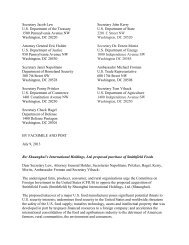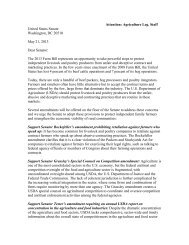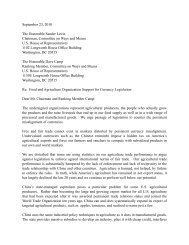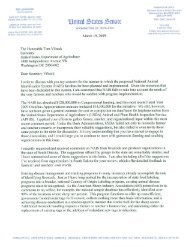Exhibit 8, 100416 Brazil FMD Risk Evaluation - R-Calf
Exhibit 8, 100416 Brazil FMD Risk Evaluation - R-Calf
Exhibit 8, 100416 Brazil FMD Risk Evaluation - R-Calf
Create successful ePaper yourself
Turn your PDF publications into a flip-book with our unique Google optimized e-Paper software.
managers that will allow APHIS to develop appropriate regulatory conditions with mitigations that<br />
address disease introduction risks posed by any initiation of trade. It also constitutes an information<br />
source for APHIS stakeholders, providing justification for the conditions in the rule. The analysis<br />
focuses on Santa Catarina’s status and control measures for <strong>FMD</strong>, SVD, CSF, and ASF.<br />
Supporting Data<br />
The analysis is based on documentation provided by MAPA, observations made by the site visit<br />
teams, and published information. The report incorporates data obtained from a site visit to Santa<br />
Catarina in 2008 and previous site visits in 2002, 2003, and 2006 to different areas of <strong>Brazil</strong>. The<br />
visits evaluated the risk of importing fresh (chilled or frozen), maturated, deboned beef into the<br />
United States. The scope of the 2002 site visit included verification of <strong>FMD</strong> outbreak controls, an<br />
overview of the surveillance program and laboratory capabilities, vaccination practices and<br />
eradication activities, and movement and border controls within <strong>Brazil</strong>. During this visit, APHIS<br />
placed particular focus on the regional <strong>FMD</strong> situation in <strong>Brazil</strong> and South America and on the risk of<br />
reintroducing <strong>FMD</strong> into <strong>Brazil</strong> from neighboring countries. The focus of the 2003 site visit was to<br />
collect data that APHIS used in our risk assessment. The focus of the 2006 site visit was to evaluate<br />
the <strong>FMD</strong> situation following the 2005 and 2006 outbreaks in the States of Mato Grosso do Sul and<br />
Paraná. The scope of the 2008 site visit was to evaluate the status of Santa Catarina with respect to<br />
freedom from <strong>FMD</strong>, CSF, ASF, and SVD.<br />
Hazard Identification<br />
APHIS has identified several World Organization for Animal Health (OIE) listed diseases [1] as the<br />
primary hazards associated with initiating trade in animals and animal products from foreign regions.<br />
APHIS addresses listed foreign animal diseases of primary concern in our regulations at title 9, Code<br />
of Federal Regulations (9 CFR), Part 94. APHIS is obligated to evaluate the status of a given region<br />
or country for specific foreign animal diseases before opening trade in susceptible species and<br />
related products with that region or country (9 CFR 92.2) [2].<br />
The hazards identified for this analysis are <strong>FMD</strong>, CSF, ASF, and SVD. Epidemiological<br />
characteristics of the disease agents relevant to the import risks they may pose are described in the<br />
Annexes.<br />
<strong>Risk</strong> Analysis<br />
This analysis has four components: the release assessment, the exposure assessment, the<br />
consequence assessment, and the risk estimation. These components are defined in OIE guidelines<br />
and represent the international recommended components for animal health import risk analyses.<br />
Release Assessment<br />
For the purpose of this report, release assessment refers to the evaluation of the likelihood that <strong>FMD</strong>,<br />
CSF, SVD, and ASF exist in Santa Catarina and, if so, the likelihood that these diseases could be<br />
introduced into the United States through imports of susceptible animals or their products from Santa<br />
APHIS <strong>Evaluation</strong> of the Status of the <strong>Brazil</strong>ian State of Santa Catarina 11











